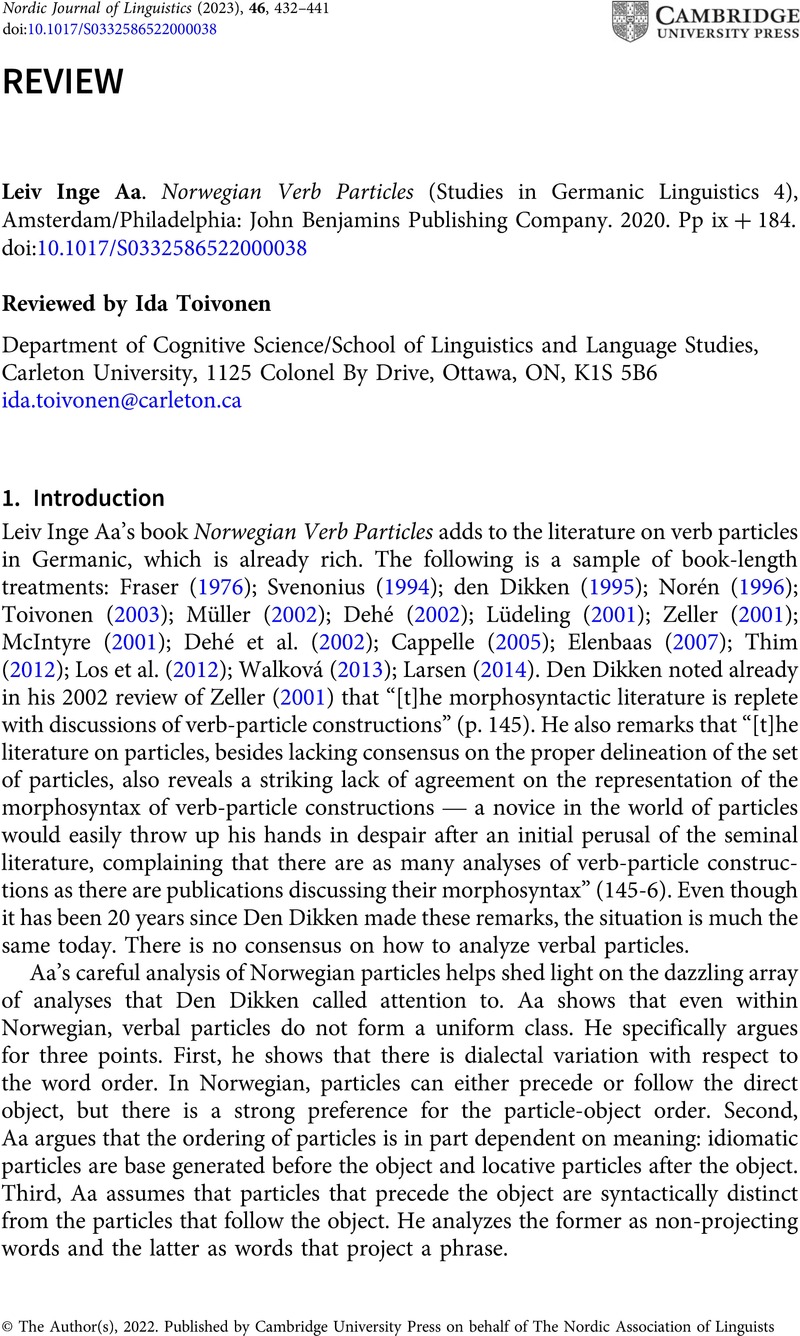No CrossRef data available.
Article contents
Leiv Inge Aa. Norwegian Verb Particles (Studies in Germanic Linguistics 4), Amsterdam/Philadelphia: John Benjamins Publishing Company. 2020. Pp ix + 184.
Review products
Leiv Inge Aa. Norwegian Verb Particles (Studies in Germanic Linguistics 4), Amsterdam/Philadelphia: John Benjamins Publishing Company. 2020. Pp ix + 184.
Published online by Cambridge University Press: 18 April 2022
Abstract
An abstract is not available for this content so a preview has been provided. Please use the Get access link above for information on how to access this content.

- Type
- Book Review
- Information
- Nordic Journal of Linguistics , Volume 46 , Special Issue 3: Call for Papers: NJL Special Issue , December 2023 , pp. 432 - 441
- Copyright
- © The Author(s), 2022. Published by Cambridge University Press on behalf of The Nordic Association of Linguists
References
Bennis, Hans. 1991. Theoretische aspekten van partikelvooropplaatsing ii. TABU, 21, 89–95.Google Scholar
Bennis, Hans. 1992. Long head movement: The position of particles in the verbal cluster in Dutch. In Linguistics in the Netherlands, Amsterdam: John Benjamins, 37-47.Google Scholar
Blom, Corrien. 2005. Complex Predicates in Dutch: Synchrony and Diachrony. PhD thesis, Vrije Universiteit Amsterdam.Google Scholar
Cappelle, Bert. 2005. Particle Patterns in English. PhD thesis, Katholieke Universiteit Leuven.Google Scholar
Dehé, Nicole. 2002. Particle Verbs in English: Syntax, Information Structure and Intonation. Amsterdam: John Benjamins,10.1075/la.59CrossRefGoogle Scholar
Dehé, Nicole. 2015. Particle verbs in Germanic. In Müller, Peter O., Ohnheiser, Ingeborg, Olsen, Susan, & Rainer, Franz (eds.), Word Formation: An International Handbook of the Languages of Europe. Berlin: Mouton de Gruyter.Google Scholar
Dehé, Nicole, Urban, Silke, McIntyre, Andrew, & Jackendoff, Ray (eds.). 2002. Verb-Particle Explorations. Berlin: Mouton de Gruyter.CrossRefGoogle Scholar
den Dikken, Marcel. 1995. Particles: On the Syntax of Verb-Particle, Triadic, and Causative Construction. Oxford: Oxford University Press.CrossRefGoogle Scholar
den Dikken, Marcel. 2002. Book review [Review of the book Particle Verbs and Local Domains, by Jochen Zeller]. Journal of Comparative Germanic Linguistics, 4, 145–179.CrossRefGoogle Scholar
Diesing, Molly. 1997. Yiddish VP order and the typology of object movement in Germanic. Natural Language and Linguistic Theory, 15, 369–427.CrossRefGoogle Scholar
Elenbaas, Marion. 2007. The Synchronic and Diachronic Syntax of the English Verb-Particle Combination. PhD thesis, Radboud Universiteit.Google Scholar
Evers, Arnold. 2003. Verbal clusters and cluster creepers. In Seuren, Pieter & Kempen, Gerard (eds.), Verb Constructions in German and Dutch, CILT 242, Amsterdam: John Benjamins, 43–89.10.1075/cilt.242.03eveCrossRefGoogle Scholar
Faarlund, Jan Terje. 2019. The Syntax of Mainland Scandinavian. Oxford: Oxford University Press.CrossRefGoogle Scholar
Fraser, Bruce. 1976. The Verb-Particle Combination in English. New York: Academic Press.Google Scholar
Herslund, Michael. 1984. Particles, prefixes and preposition stranding. In Heltoft, Lars & Sørensen, Finn (eds.), Topics in Danish Syntax (Nydanske Studier & Almen Kommunikationsteori, 14). Copenhagen: Akademisk Forlag.Google Scholar
Hulthén, Lage. 1948. Studier i jämförande nunordisk syntax. Gothenburg: Elanders boktryckeri.Google Scholar
Johannessen, Janne Bondi, Priestle, Joel, Hagen, Kristin, Anders Åfarli, Tor, & Vangsnes, Øystein. 2009. The Nordic Dialect Corpus: An Advanced Research Tool. In Jokinen, Kristiina and Bick, Eckhard (eds.), Proceedings of the 17th Nordic Conference of Computational Linguistics NODALIDA 2009, 73–80.Google Scholar
Kvist Darnell, Ulrika & Wide, Camilla. 2002. Reflexiva partikelverb och liknande konstruktioner is sverigesvenska och finlandssvenska. In Sundman, Marketta & Londen, Anne-Marie (eds.), Svenskans beskrivning 25, Nordisk filologi, Åbo Universitet, 108-119.Google Scholar
Larsen, Darrell. 2014. Particles and Particle-Verb Combinations in English and Other Germanic Languages. PhD thesis, University of Delaware.Google Scholar
Le Roux, Cecile. 1988. On the Interface of Morphology and Syntax: Evidence from Verb-Particle Combinations in Afrikaans. Master’s thesis, University of Stellenbosch.Google Scholar
Los, Bettelou, Corrien Blom, Geert Booij, Elenbaas, Marion, & van Kemenade, Ans. 2012. Morphosyntactic Change: A Comparative Study of Particles and Prefixes. Cambridge: Cambridge University Press.10.1017/CBO9780511998447CrossRefGoogle Scholar
Lüdeling, Anke. 2001. On Particle Verbs and Similar Constructions in German. Stanford: CSLI Publications.Google Scholar
Lundquist, Björn. 2014a. Verb particles: active verbs. The Nordic Atlas of Linguistic Structures, 10(1), 110–118.Google Scholar
Lundquist, Björn. 2020. Argument placement in Faroese. The Nordic Atlas of Linguistic Structures, 50(1), 5–27.Google Scholar
McIntyre, Andrew. 2001. German Double Particles as Preverbs: Morphology and Conceptual Semantics. Tübingen: Stauffenburg.Google Scholar
Müller, Stefan. 2002. Complex Predicates: Verbal Complexes, Resultative Constructions, and Particle Verbs in German. Stanford: CSLI Publications.Google Scholar
Neeleman, Ad & Weerman, Fred. 1993. The balance between syntax and morphology: Dutch particles and resultatives. Natural Language and Linguistic Theory, 11, 433–475.10.1007/BF00993166CrossRefGoogle Scholar
Norén, Kerstin. 1996. Svenska partikelverbs semantik. Gothenburg: Acta Universitatis Gothoburgensis.Google Scholar
Sandøy, Helge. 1976. Laust samansette verb i vestnordisk: ein samanliknande ledstillingsanalyse for islandsk, færøysk og romsdalsmål. Magister dissertation, University of Oslo.Google Scholar
Svenonius, Peter. 1994. Dependent Nexus: Subordinate Predication Structures in English and the Scandinavian Languages. PhD thesis, University of California at Santa Cruz.Google Scholar
Svenonius, Peter. 1996. The optionality of particle shift. Working Papers in Scandinavian Syntax, 57, 47–75.Google Scholar
Taraldsen, Knut Tarald. 1983. Parametric Variation in Phrase Structure. PhD thesis, University of Tromsø.Google Scholar
Thim, Stefan. 2012. Phrasal Verbs: The English Verb-Particle Construction and its History. Berlin: Mouton de Gruyter.CrossRefGoogle Scholar
Thráinsson, Höskuldur. 2007. The Syntax of Icelandic. Cambridge: Cambridge University Press.10.1017/CBO9780511619441CrossRefGoogle Scholar
Toivonen, Ida. 2002. The directed motion construction in Swedish. Journal of Linguistics, 38(2), 313–345.CrossRefGoogle Scholar
Toivonen, Ida. 2003. The Phrase Structure of Non-Projecting Words: A Case Study of Swedish Particles. SNLLT 58. Dordrecht: Kluwer.10.1007/978-94-010-0053-6CrossRefGoogle Scholar
Vikner, Sten. 1987. Case assignment differences between Danish and Swedish. In Allan, Robin M.S. & Barnes, Michael P. (eds.), Proceedings of the 7th Biennial Conference of Teachers of Scandinavian Studies in Great Britain and Northern Ireland, 262–281. London: University College London.Google Scholar
Vikner, Sten. 2016. Verbalpartikelvariation i de germanske sprog. Ny forskning i grammatik, 23, 233–252.Google Scholar
Walková, Milada. 2013. The Aspectual Function of Particles in Phrasal Verbs. PhD thesis, University of Groningen.Google Scholar
Zeller, Jochen. 2001. Particle Verbs and Local Domains. Amsterdam: John Benjamins.10.1075/la.41CrossRefGoogle Scholar



